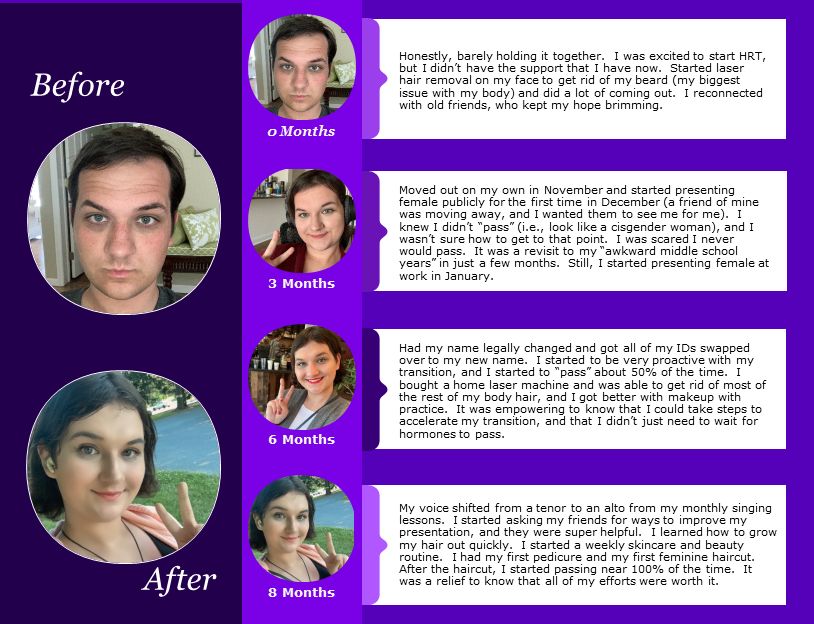Transcending the Mask

By Amelia Conway, Digital Data Change Leader
My name is Amelia. I’m a project manager, programmer, singer, cook, and poet. I also happen to be a trans woman. I was born biologically male, but later in life became the woman I always knew I was on the inside. This is my story of how I managed to face my fears and embrace who I knew myself to be.
As a child, I didn’t have to worry about my identity as much. Lines separating what’s appropriate for boys and girls were blurred, as some fluidity was accepted. If I wanted to be Lady Liberty for Halloween, or if I wanted a pink Nintendo DS, it was a non-issue. I was happy to express myself regardless of stereotypes. I was called “gentle”, “smiley”, “sensitive,” and “always trying to help others”.
Everything changed after my natal puberty. This once bubbly child was now a selfish brooding teen, traumatized by the changes it wrought. Puberty is difficult for everyone, but especially so for trans people. I felt like my body betrayed me. I didn’t know why I felt this way, or what I could do to stop it.
As puberty started, I experienced my first encounter with gender dysphoria, a mismatch between mind and body that causes distress. It felt like I was trapped in a prison, and that the more I tried to fight it, the more claustrophobic my cell became. I was stuck, thrust into an identity that never matched who I was. Family members complimented my changes, saying “look at how strong and tall you’re getting!”. But something seemed wrong to me. The changes made me sick; I’d do everything I could to hide them. Every day, I’d shave my body and facial hair, desperate to hide them, but they’d grow back even thicker.
Socially, things were no better. I felt extremely uncomfortable changing clothes in front of boys my age, so I’d hide away in a stall until everyone had left. Others caught on to these unusual tendencies, so I became a target for bullying. The once cheerful child was no more. I closed myself off from the world, avoiding social events and sitting alone at lunch. I was shamed for my feminine mannerisms, and I internalized the bullying, seeing my femininity as a weakness that needed to be hidden away.
In high school, I was desperate to prevent the bullying from reoccurring. To protect myself, I created artificial versions of myself that I called “masks”. I would show others what I thought they wanted to see, masquerading the real me. If I made myself fit in the box I was given, maybe I’d be happy.
Maintaining my disguises sapped away my mental energy. I felt like I was always on guard; I was always anxious and irritable. The weight of putting on a performance every day bogged me down. It was a “death by a thousand cuts,” and I lost touch with who I was. For 7 years, I was so emotionally removed that I became physically unable to cry. I was hypercritical of others and myself, and my heart turned cold.
For those years, I was afraid to remove my masks; while taking them off might set me free, I had an ego and reputation to uphold. I felt it was more important to maintain the image of a “perfect child,” and I deluded myself into thinking that I was making some type of noble sacrifice. I felt nobody really wanted to see the real me. It took me until college graduation that I was finally able to help myself.
Between graduation and starting work at Sanofi, I took the time to look inward and to ask myself the big questions: Who was I? And what did I want? Through this reflection process, I discovered that I wasn’t alone in my gender struggle. There was a broader community of people who felt this misalignment, and what’s more, many of them were able to alleviate their dysphoria through treatment called hormone replacement therapy (HRT). Cross-sex hormones could help to feminize my body, aligning it with my brain. For the first time in years, I gave a genuine smile – I might be able to finally be myself!
Hormones would change my physical appearance quite a bit, so there was no more hiding for me. I was frightened coming out to my family, friends, and coworkers (especially after hiding), but the alternative wasn’t an option. Soon after, I started my first dose of HRT. A half hour after I took my first dose, a big, genuine smile swept across my face as I felt a balance for the first time. I was finally me!
I’ve been on hormones for about 8 months and have since matured from a trans girl to a trans woman. This process taught me so much about myself, and it has given me perspective on the social issues that men and women face. It was far from a steady journey, and though I still experience bouts of dysphoria, they’re far fewer and less severe than they were pre-transition. It’s thanks to my coworkers and my friends that I was able to get this far. Everyone at work has been supportive and inclusive, and some even went above and beyond to introduce me to their trans friends and to help with my legal transition. I couldn’t be where I am today without such a kind and supportive environment at work!
I’d love nothing more than to live in a world where everyone can become the best version of themselves they can be. We shouldn’t be afraid to embrace who we are – that’s what makes us special. It’s in overcoming this fear that I’ve been able to embrace who I am, and I’m proud to be me!
